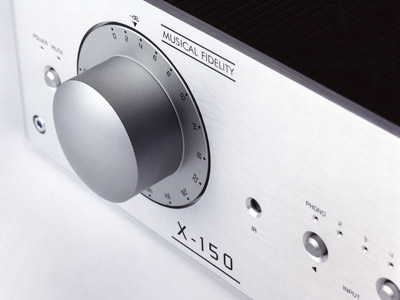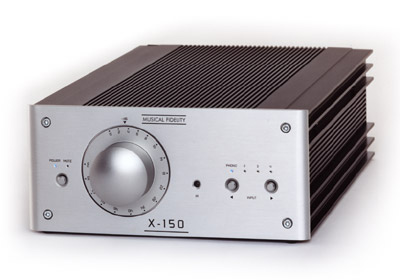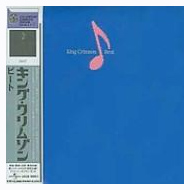You are reading the older HTML site
Positive Feedback ISSUE
19
may/june 2005
musical fidelity
X-150 integrated amplifier
as reviewed by John Acton

|
JOHN ACTON'S SYSTEM
LOUDSPEAKERS
ELECTRONICS
SOURCES
CABLES
ACCESSORIES
|
What defines high-end audio? Is it price? Appearance? Quality of construction? Or is it sound quality? If sound quality is paramount, what aspects are critical? Deep bass? Airy treble? Soundstaging? Dynamics? Musical Fidelity makes a lot of audio components, the flagship models of which they claims to be the finest in the world. This is not a unique claim, as many manufacturers make it. What separates Musical Fidelity products from those of other manufacturers is their relatively low cost.
The subject of this review is not one of Musical Fidelity's flagship models—the X-150 integrated is their second least expensive amplifier. They freely admit that the X-150 is not designed to challenge more exotic amplifiers, but do declare it to be a high-end product. They also call it "pretty good for the money." The X-150 costs $995 in the United States and 800 pounds in the UK, which translates to roughly $1500, so Musical Fidelity is not making a lot of profit on this amplifier, at least in the US. Perhaps this is a strategy to get people in the door, and Musical Fidelity is gambling that when upgrade time comes along, X-150 owners will move up the chain to one of their more expensive offerings.
The X-150‘s appearance and build quality belies its price. The casework is substantial, and does double duty as the heatsink for the amp. The faceplate is as substantial as the casework, and is done up in classy brushed aluminum. A large rotary volume control dominates the front of the amp, and is complemented by an on/off button on the left and two source-selection buttons on the right. Two discreet blue lights indicate power and the source selected. Only on the back of the amp does it become apparent that the X-150 has been engineered to a price point, with RCA inputs and five-way speaker binding posts that are merely adequate. Like other X-series components, the X-150 is half width, at 8.6 inches. Height and depth are, respectively, 3.8 and 14.9 inches. Weight is 14 pounds.

The X-150 has inputs for three line-level sources and, surprisingly at the price, a moving-magnet phono input. A remote control provides the ability to raise and lower volume, change source, and mute the amplifier. Tape and preamp outputs are provided. Musical Fidelity states that the circuit design of the X-150 is derived from that of the company's much more expensive Nu-Vista integrated. Separate power transformer windings are provided for the preamp and power amp sections, and four high-power output devices per channel are utilized. Interestingly, the power output specs for the X-150 vary by source. The average published spec is 80 watts per channel into 8 ohms, increasing to 140 into 4 ohms.
Installing the X-150 into my system was a snap. The amp's light weight and small size made it easy to maneuver. The bottom of the amp eschews points, blocks, or feet in favor of two neoprene runners. Just sit it down and forget it. Cable connections were likewise easy to make, the only caveat being the fact that the inputs are very close together, and close to the speaker outputs. The X-150 was broken in when I got it, but I found that it needed to be warmed up to perform at its best, and I left it powered up during the course of my review.
Sufficiently warmed up, the X-150 sounded warm, rich, and big. One of the few downsides I noted in my review of the marvelous ProAc Tablette Reference 8 Signature loudspeakers was their inability to sound big when played at low volume, but this was largely rectified by the insertion of the X-150 into my system. I could listen at low volumes without losing verisimilitude.
The midrange was the real strength of this amp. Thomas Dolby and Eddi Reader, singing on "Cruel" from Dolby's Astronauts and Heretics (Giant 24478-2), sounded warmer and richer than usual, and the extra body contributed a bigger, lusher sound to this slightly dry recording. Roger Waters' Radio K.A.O.S. (Columbia CK 40795) is well recorded, but is plagued by the sterility typical of late-80s digital recordings. The X-150 did a great job of fleshing out Waters' vocals. Dynamic shifts were also well handled, with the X-150's high-current design really taking charge of my ProAc Tablettes. "Who Needs Information" was another excellent example of this, with the subtle shadings of the verses giving way to the bombastic chorus with startling effortlessness.
 The X-150's handling of King Crimson's
Beat
(EG Records 724381011621) was likewise full-bodied and natural. Adrian
Belew's voice on "Waiting Man" and "Two Hands" sounded as full and warm
and present as I've ever heard it. Considering the price of the amp,
this was very impressive. Soundstaging was also very good, with images
not at all locked to the speakers, but floating above and beyond them.
The amp again sounded big, and made my ProAcs sound larger than their
small enclosures and drive units warranted. Nevertheless, this same
album exhibited a couple of areas in which the X-150 was less
successful. High frequencies sounded a little mechanical and
transistorized, and there was a slight lack of air in the top octave.
Bill Bruford's cymbal work occasionally had a shut-in, white-noise-like
quality. And while the soundstaging was quite good in width and height,
the X-150 was not as good at portraying a sense of depth, nor could it
delineate images well. There was a homogenization within the soundstage,
and the somewhat flat presentation made it difficult to follow the
complex guitar interplay of Belew and Robert Fripp.
The X-150's handling of King Crimson's
Beat
(EG Records 724381011621) was likewise full-bodied and natural. Adrian
Belew's voice on "Waiting Man" and "Two Hands" sounded as full and warm
and present as I've ever heard it. Considering the price of the amp,
this was very impressive. Soundstaging was also very good, with images
not at all locked to the speakers, but floating above and beyond them.
The amp again sounded big, and made my ProAcs sound larger than their
small enclosures and drive units warranted. Nevertheless, this same
album exhibited a couple of areas in which the X-150 was less
successful. High frequencies sounded a little mechanical and
transistorized, and there was a slight lack of air in the top octave.
Bill Bruford's cymbal work occasionally had a shut-in, white-noise-like
quality. And while the soundstaging was quite good in width and height,
the X-150 was not as good at portraying a sense of depth, nor could it
delineate images well. There was a homogenization within the soundstage,
and the somewhat flat presentation made it difficult to follow the
complex guitar interplay of Belew and Robert Fripp.
Jim Kirkwood's brand of gothic electronica is a challenge for any component. His The Darkening Hour (Dark Age Music D.A.M 2) contains a complex, multi-tracked mix of ominous chanting, tribal beats, mellotron flutes, drum machines, and layer upon layer of synthesizers. When things really got cooking, the X-150 produced a slightly murky simulacrum of the recorded performance.
Steeleye Span's Ten Man Mop or Mr. Reservoir Rides Again (Shanachie SH 79049) is musically terrific but sonically mediocre. With the X-150, I found it a truly enjoyable listening experience from start to finish, but this may have been because the recording did not challenge the amplifier's resolution abilities. The recording sounded totally convincing both tonally and spatially, and Maddy Prior's soaring voice never sounded better on "Captain Coulston" and "Wee Weaver."
Comparing the Musical Fidelity X-150 to my reference Audio Zone Amp-1 (at twice the price and half the output) proved interesting. The X-150 was warmer and richer, and made the Amp-1 sound slightly cold, dry, and sterile. The X-150 had a way with vocals that the Amp-1 could not match, and it sounded much larger. The Amp-1, on the other hand, was quicker, more transparent, and more extended at both ends of the frequency spectrum. The Amp-1 did a better job with complex music. Instruments did not collapse into a murky morass, as they had a tendency to do with the X-150. I found myself listening to more of my digital-sounding CDs with the X-150, as its warmer, more forgiving, and less transparent signature lent itself to these drier-sounding recordings. More complex fare was better portrayed over the Amp-1.
Is the Musical Fidelity X-150 a giant killer? Yes and no. Its warmth and richness far exceeded my expectations for an amp in its price range. On the other hand, better sound can be had, especially with respect to resolution, transparency, and extension, albeit at considerably higher cost. Is the X-150 a high-end component? I prefer to think of it as a gateway to the high end. While listeners can spend a long time getting high on music with the X-150, the amp is paradoxically good enough to have them wondering what else is out there. "Pretty good for the money," Musical Fidelity thinks. Damn good for the money, I think. John Acton
X-150
Retail: $995
Musical Fidelity
web address:
www.musicalfidelity.com
